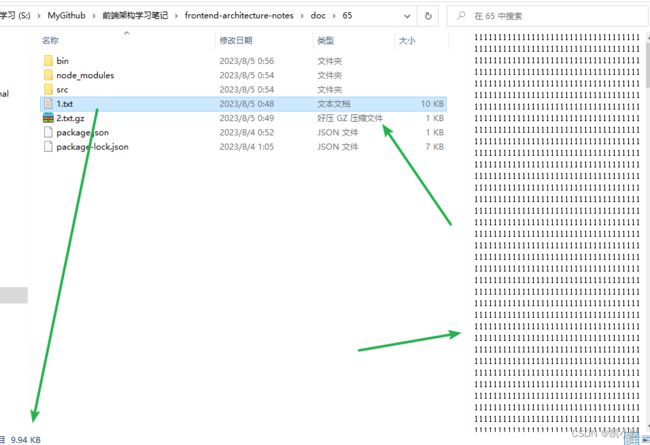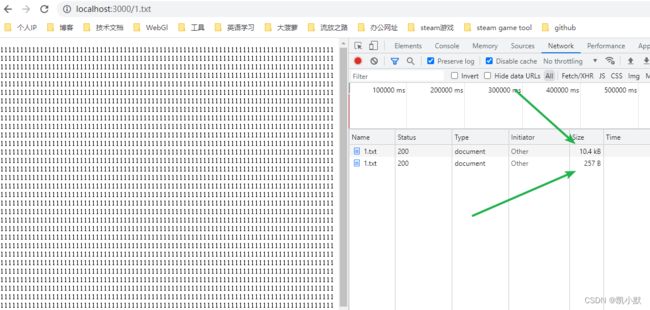65 # 实现 http-server 里的 gzip 压缩
用 zlib 来实现 gzip 压缩
服务端优化都是:压缩 + 缓存
前端可以通过 webpack 插件进行压缩
gzip 根据替换来实现的,重复率越高,压缩后的结果越小
const zlib = require("zlib");
const fs = require("fs");
const path = require("path");
方式一:读取文件压缩,如果文件大的话都读取到内存中,耗内存
zlib.gzip(fs.readFileSync(path.resolve(__dirname, "./65/1.txt")), (err, data) => {
fs.writeFileSync(path.resolve(__dirname, "./65/2.txt.gz"), data);
});
方式二:用转化流(可读可写)的方式,服务端的文件 => 压缩 => 客户端
fs.createReadStream(path.resolve(__dirname, "./65/1.txt"))
.pipe(zlib.createGzip())
.pipe(fs.createWriteStream(path.resolve(__dirname, "./65/2.txt.gz")));
新建 1.txt 文件用来测试压缩,里面写的都是1,大概有个 10k 的样子,两种方式执行之后都会生成压缩文件 2.txt.gz,如下
代码实现 http-server 里的 gzip 压缩
下面实现 http-server 里的 gzip 压缩
实现思路就是根据请求头 header [accept-encoding] 里是否包含 gzip 来判断浏览器是否支持 gzip 压缩,如果支持就创建转化流处理。
在上一节的 server.js 里面添加代码如下
// 核心模块
const http = require("http");
const path = require("path");
const url = require("url");
const fs = require("fs").promises;
const { createReadStream, createWriteStream, readFileSync } = require("fs");
// 第三方模块
const ejs = require("ejs"); // 服务端读取目录进行渲染
const mime = require("mime");
const chalk = require("chalk");
const debug = require("debug")("server");
// 根据环境变量来进行打印 process.env.EDBUG
debug("hello kaimo-http-server");
// 同步读取模板
const template = readFileSync(path.resolve(__dirname, "template.ejs"), "utf-8");
class Server {
constructor(config) {
this.host = config.host;
this.port = config.port;
this.directory = config.directory;
this.template = template;
}
async handleRequest(req, res) {
let { pathname } = url.parse(req.url);
// 需要对 pathname 进行一次转义,避免访问中文名称文件找不到问题
console.log(pathname);
pathname = decodeURIComponent(pathname);
console.log(pathname);
// 通过路径找到这个文件返回
let filePath = path.join(this.directory, pathname);
console.log(filePath);
try {
// 用流读取文件
let statObj = await fs.stat(filePath);
// 判断是否是文件
if (statObj.isFile()) {
this.sendFile(req, res, filePath, statObj);
} else {
// 文件夹的话就先尝试找找 index.html
let concatFilePath = path.join(filePath, "index.html");
try {
let statObj = await fs.stat(concatFilePath);
this.sendFile(req, res, concatFilePath, statObj);
} catch (e) {
// index.html 不存在就列出目录
this.showList(req, res, filePath, statObj, pathname);
}
}
} catch (e) {
this.sendError(req, res, e);
}
}
// 列出目录
async showList(req, res, filePath, statObj, pathname) {
// 读取目录包含的信息
let dirs = await fs.readdir(filePath);
console.log(dirs, "-------------dirs----------");
try {
let parseObj = dirs.map((item) => ({
dir: item,
href: path.join(pathname, item) // url路径拼接自己的路径
}));
// 渲染列表:这里采用异步渲染
let templateStr = await ejs.render(this.template, { dirs: parseObj }, { async: true });
console.log(templateStr, "-------------templateStr----------");
res.setHeader("Content-type", "text/html;charset=utf-8");
res.end(templateStr);
} catch (e) {
this.sendError(req, res, e);
}
}
gzip(req, res, filePath, statObj) {
if (req.headers["accept-encoding"] && req.headers["accept-encoding"].includes("gzip")) {
// 给响应头添加内容编码类型头,告诉浏览器内容是什么编码类型
res.setHeader("Content-Encoding", "gzip");
// 创建转化流
return require("zlib").createGzip();
} else {
return false;
}
}
// 读取文件返回
sendFile(req, res, filePath, statObj) {
// 设置类型
res.setHeader("Content-type", mime.getType(filePath) + ";charset=utf-8");
// 读取文件进行响应
// 先判断浏览器是否支持 gzip 压缩
let gzip = this.gzip(req, res, filePath, statObj);
if (gzip) {
createReadStream(filePath).pipe(gzip).pipe(res);
} else {
createReadStream(filePath).pipe(res);
}
}
// 专门处理错误信息
sendError(req, res, e) {
debug(e);
res.statusCode = 404;
res.end("Not Found");
}
start() {
const server = http.createServer(this.handleRequest.bind(this));
server.listen(this.port, this.host, () => {
console.log(chalk.yellow(`Starting up kaimo-http-server, serving ./${this.directory.split("\\").pop()}\r\n`));
console.log(chalk.green(` http://${this.host}:${this.port}`));
});
}
}
module.exports = Server;
我们启动服务,去访问 http://localhost:3000/1.txt
kaimo-http-server
跟没有压缩的对比如下:

